Full Test
The timing couldn't be any better for the Europeans. At a time when the Japanese manufacturers are scaling back on the rapid pace of their sportbike development cycles, European makes are pooling together all of their resources to take the fight to the Japanese literbikes head on. When Aprilia announced the RSV4 Factory as its superbike contender, the others took notice. With a long lasting Grand Prix heritage, mainly in the 250cc championship, the factory had a long line of experience to draw from when designing its flagship model. The goal was simple: Design a world-class 1000cc superbike with the handling capabilities of the 250cc racers that have won numerous world championships to date. Of course, a company like Aprilia wouldn't stand for employing conventional methods, either. Instead of an inline four like the Japanese (and BMW) the folks at Noale chose a Vee configuration for the engine. Not a V-twin, mind you, but a V-four of 999cc to keep within the World Superbike rules mandating engine size for four-cylinder machines. And with the Factory model comes the top-shelf components we've come to expect from Aprilia, but more on that later.
Building On A Racing Heritage
By now you've surely seen Max Biaggi's successful 2009 World Superbike campaign, riding for the same manufacturer that brought him three world 250cc titles. If you've looked closely you may have noticed just how small the bike really is: Biaggi's about the size of a horse jockey, but aboard the RSV4 Factory he looks, dare I say, normal. His stellar performance aboard a brand new machine in its first year of competition had us journalist types chomping at the bit for our chance to ride the production version. That chance came when our European correspondent, Alan Cathcart, sweet-talked his way into spinning some dry laps around the Adriatico Misano circuit in Italy during the mainly wet world press introduction ("Reborn Return", July '09).
Cathcart was glowing after his stint on the machine, which made our anticipation for a full shakedown that much harder to handle. That time has come, however, and the bike surely delivered some surprises, both good and bad. We put the 'Priller on the dyno, took it through the canyons, wrung its neck for top speed numbers and quarter mile times as well as lived with the machine for awhile. About the only thing we didn't do is take it to the track due to scheduling conflicts with the local racetracks during our December test schedule when we possessed the bike. It just so happens we had some of the '09 literbikes, like the Honda CBR1000RR, Kawasaki ZX-10R and Suzuki GSX-R1000 still around from last year's literbike shootout and we brought them along as a pseudo benchmark to see where the RSV4 stacked up (more on that in the accompanying sidebar).
Building On Success
When we saw the bike on television during the World Superbike races we knew it was going to be tiny, but seeing the bike in the flesh for the first time really revealed just how compact it really is. Total wheelbase is just 55.9 inches, but its super compact dimensions make you think you're on a much smaller displacement machine. There's no doubt of its racing heritage as its seating position places the rider up high, with the rearsets up and back, giving a comanding view of the road at the expense of your wrists. Your bum will be hurting too since the saddle is unforgiving-just like its racing ancestors.
Thumb the starter and the 65-degree V-four actually takes a few cranks to fire up. Once alive the four cylinders bark loudly despite the gargantuan exhaust pipe jutting out the side. As Cathcart mentions in his First Ride piece, the Vee engine configuration was choosen to maintain as narrow and compact a platform as possible. Inside, the 78.0 x 52.3mm bore and stroke make for a largely oversquare architecture. Compression ratio is a stout 13:1 and the cylinders are fed air via 48mm throttle bodies that incorporate variable length intake tracts, much like those seen on the Yamaha YZF-R1 and R6. Twin injectors ensure that enough fuel gets burned up when the right wrist gets heavy.
Sounds Good On Paper, But Does It Work? ...
Once underway the RSV4 Factory is quite composed even when you're not at the racetrack (which is more than could be said about other Italian superbikes). Steering lock is much more generous than that other Italian manufacturer's and makes slow speed manuevers much easier. Surprsingly, vibes are under control once sitting on the bike. That's thanks to the single counterbalancer.
But this bike isn't about going slow-not at all. Twist the throttle and she comes to life. The Magnetti Marelli electronics meter the fueling precisely without any hiccups at partial throttle. Power is on tap from down low on the tachometer and builds effortlessly until just shy of its 14,200 rpm redline. Some testers noted a slight soft spot around 8000rpm; likely a result of complying with Euro 3 emissions regulations. Of course, this was with the RSV4 set in the Track drive mode setting. The most aggressive of the three modes, Track unleashes all of the bike's power all of the time. Meanwhile, Sport mode dials back the torque by 25 percent in the first three gears and Road reduces overall power by 25 percent all the time.
Switching between the different modes is anything but intuitive as there are no clear markings for which buttons to push. As it turns out, pressing and holding the ignition button (with the throttle closed) for a few seconds backlights the different modes on the LCD gauge cluster. Toggle through with the "Mode" switch on the left bar and, once the desired mode is found, it'll be engaged after one second of inactivity. Sound confusing? That's because it is. We found that, even in Track mode, power delivery was slightly lazy, especially compared to past Aprilias we've ridden where Sport mode (previously the most powerful of the three settings) would cause the motorcycle to lurch forward even at the slightest of throttle openings. This goes against Cathcart's initial impressions at the world intro in Italy, where he complained that Track mode was almost unrideable due to its strong power surge. A result of Aprilia using "special" models at the intro, perhaps? Who knows...
Since the RSV4 Factory takes direct inspiration from its 250cc Grand Prix counterpart, there should be one area that this motorcycle excels in above all else: handling.
...Boy does it ever.
Sure the power isn't as lethal as we were originally expecting, but the bike's agility and extremely precise handling more than make up for any of the engine's perceived flaws (not that the bike is slow by any means). That narrow engine is housed in a pressed sheet and cast aluminum chassis with a 43mm inverted Öhlins fork that offers full adjustability. Obviously an Öhlins shock lies out back (though not the TTX variety), also with full adjustability. Rather modest rake and trail figures of 24.5 degrees and 4.1 inches, respectively (for comparison, the Ducati 1098R measures 24.3 degrees and 3.8 inches) belie the almost telepathic handling capabilities. The RSV4 goes where you want it to go even before you know where you want to go. Turn-in takes but a mere thought with rock-solid stability while leaned over. Note however that the Öhlins bits are sensitive to adjustments-even two clicks in either direction changes the attitude dramatically. Get it right though and you'll soon be singing its praises. Surely the light weight of the forged Marchesini wheels account for a large chunk of this cornering nirvana, and with the gobs of confidence the front end inspires you can literally place the bike anywhere mid-corner. All of our testers were unanimous in their praise for the Aprilia's handling, with Trizzle scribbling in his notes, "Screw 600s, this thing handles like a 250!"
And that's the point. We're not exagerating when we say that the RSV4 Factory is one of the best handling motorcycles we've ever ridden, production bike or otherwise. But there's more to a motorcycle than its agility. Every now and then you need to slow down and stop. That's where the 320mm discs up front come in handy. Brembo four-piston monoblock calipers each carry just two pads, but they bring the action to a halt with more than enough fervor. While the brakes are what you'd expect, lever feel leaves a little to be desired. Also, lever adjustability feels suited towards those with larger hands as even with the lever at its closest setting, reaching it with two fingers is a bit of a stretch.
Good Things Are Worth Waiting For
In case you haven't noticed by now, this bike is a hit among our staff. Our impressions from our time aboard the machine have been glowing and there's no doubt we can't wait to take this bike to the racetrack. One needs to remember, however, that the RSV4 Factory truly desires to live on the track and not on the street. As we mentioned earlier the seating position is heavenly when chasing lap times, but at all other times you better have your chiropractor on standby. Aprilia makes no apologies for this and if you insist on riding through the pain then there are some surprises in store. It's actually roomy for sub six-footers, with decent wind protection from its tiny windscreen. As with most Italian exotica, mirrors are practically useless, but when you're on a racetrack what's behind you doesn't matter anyway. Another feature of Italian exotica is the price of admission. At $20,999 the RSV4 Factory isn't for everybody, but if you can afford to pay then you'll certainly be rewarded when it comes time to play. Stay tuned for a future issue when we pit this bike against its literbike counterparts.
'10 Aprilia RSV4 Factory
Engine
Type: Liquid-cooled, 65-deg., 4-stroke V-four, DOHC, 4 valves/cyl.
Displacement: 999cc
Bore x stroke: 78.0 x 52.3mm
Compression ratio: 13.0:1
Induction: Magnetti Marelli EFI with 48mm throttle bodies with electronic actuation, twin injectors/cyl. Transmission: 6-speed
Chassis
Front suspension: 43 mm Ohlins inverted cartridge fork, 4.7 in. travel, adjustable for spring preload, rebound and compression damping
Rear suspension: Single Ohlins shock absorber, 5.1 in. travel; adjustable for spring preload, rebound and compression damping
Front wheel: 3.50 x 17 in.; forged aluminum alloy
Rear wheel: 6.0 x 17 in.; forged aluminum alloy
Front tire: 120/70-ZR17 Pirelli Diablo Supercorsa SP
Rear tire: 190/55-ZR17 Pirelli Diablo Supercorsa SP
Rake/trail: 24.5 deg./4.13 in. (105mm)
Wheelbase: 55.9 in. (1420mm)
Seat height: 33.3 in. (845mm)
Fuel capacity: 4.5 gal. (17L)
Weight: 462 lb (210 kg) wet; 435 lb (197 kg) dry (wet minus fuel)
Instruments: LCD panel for digital speedometer, analog tachometer, digital odometer/tripmeter, temperature gauge, clock, drive modes, fuel reserve, average and instantaneous fuel consumption, neutral, high beam, turn signals, low oil pressure
Performance
Quarter mile: 10.01 sec. @ 143.22 mph (corrected) Top speed: 185.3 mph
Roll-ons: 60-80mph/3.10 sec.; 80-100mph/3.13 sec.
Fuel consumption: 29 to 31 mpg, 29.7 mpg average
'10 Aprilia RSV4 Factory
Jim O'Connor
I was excited to ride the new Aprilia RSV4. It's not often I get a chance to ride a high-performance V-four. Besides, I used to own a 1998 Interceptor. The engine was great, although I never will understand why some manufacturers are all about different engine modes these days. I've never found much use with them and I'm still not convinced. The RSV4 turned effortlessly and noticeably quicker than the other motorcycles we were riding. It also felt quite a bit lighter and smaller. The engine would spin quickly and the transmission was crisp. A little bit of effort on the brakes went a long way. The bad news is the seat is hard, the mirrors are useless and oh, did I mention it's twenty one thousand dollars? But hey, having the latest bad-ass sport bike from Italy is going to cost you so start saving your pennies.
Steve Mikolas
The RSV4 Factory may be compact, light weight and minimalist, but it begs to be stripped down even more. After the first round of musical bikes with those bully-in-line fours, the initial thought was why bother installing a useless set of passenger pegs and mirrors on this Italian work of art?
Calling this a street bike doesn't jive with this machine-unless you happen to have a nice set of twisties or a race track in your backyard. I really try and refrain from using all the clichés that have become standard over the years but this bike begs several: thoroughbred, a focused machine, and race-oriented cutting-edge technology all come to mind. The Aprilia still has its work cut out when trying to outrun the mighty Kawasaki ZX-10R though. All things considered, the word "Factory" is not a stretch in the case of the all new RSV4 and for 21 grand it better not be! You get your money's worth as long as you have the expertise to fully appreciate the Aprilia's capabilities. Oh, and I almost forgot...the words "beyond sick" in describing this Italian beauty.
Troy Siahaan
You know that feeling when a new movie comes out and all your friends tell you how great it is? You then watch the movie with high expectations hoping that you come away fulfilled. Unfortunately, that rarely happens. This Aprilia is the exception. A friend of mine was one of the first to receive his RSV4 Factory just days prior to our scheduled delivery and couldn't (or should I say wouldn't) stop raving about it. So naturally I was cautiously optimistic when throwing a leg over it for the first time. But it didn't disappoint-not at all. Like Jim, I'm not a big fan of different drive modes either, but I'll gladly forgive Aprilia if that's the biggest gripe I have about the bike. The sensitive suspension could be a pain for the uninitiated, but once we got it dialed I couldn't stop smiling. Granted I've never ridden a 250 GP bike, but otherwise I've never ridden something that handles as crisp and precise as the RSV4 Factory. If we can find a way to give it that brutal knock-your-teeth-out power that the ZX-10R has then I think we might have a contender for bike of the year.
Kent Kunitsugu
This year may just go down as the "Year of the European Sportbike". While the Japanese manufacturers are building defensive positions and hunkering down in their trenches as they try to ride out the economic storm, the Europeans are clearly on the offensive. The Japanese have enjoyed a long and prosperous reign atop the sportbike heap, but if they don't react quickly-despite the obvious financial difficulties that are affecting everyone-that supremacy is in serious danger.
The Aprilia RSV4 Factory is the real deal. Strong yet very flexible engine, ultra-sharp chassis, superb suspension, brick-wall brakes-it will basically run rings around the current Japanese machinery that are certainly no slouches when it comes to performance. It may be lacking a little steam up top, but the only place where that will show is on a dragstrip or racetrack with long straights.
Yes, the RSV4 Factory's price tag is a little steep. But most people in the market for a literbike aren't pinching pennies-and if that sticker is a deal-breaker, then the "standard" RSV4 R model (which we'll be testing soon) is a good fall-back plan.










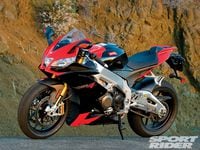
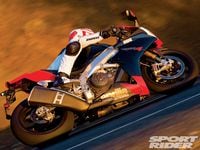
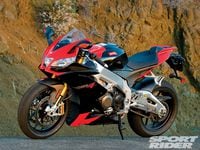
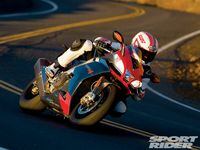

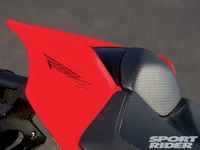
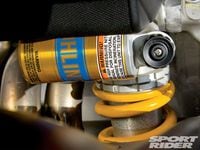
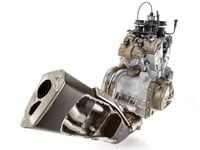
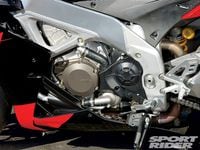
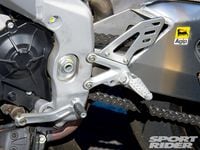
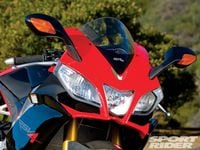
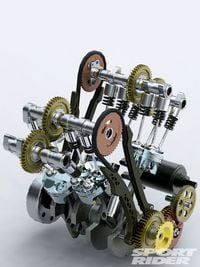
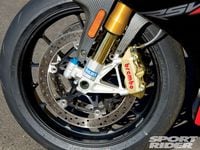
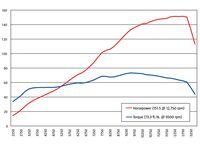
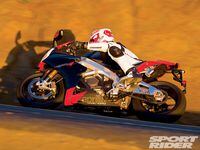
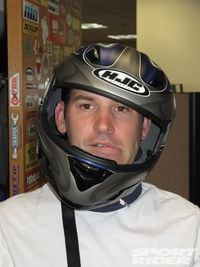



/cloudfront-us-east-1.images.arcpublishing.com/octane/EFFSPCZVBBCMTNGVEQMB7NNKIU.jpg)
/cloudfront-us-east-1.images.arcpublishing.com/octane/5GP3PUGFKVGUVCEYG4ZBDYLNBE.jpg)
/cloudfront-us-east-1.images.arcpublishing.com/octane/USTSFGXT3ZGL7BT7B66WMSSKTI.jpg)
/cloudfront-us-east-1.images.arcpublishing.com/octane/Z7YU6FSR6NEKVMKT5CZPMKIVLE.jpg)
/cloudfront-us-east-1.images.arcpublishing.com/octane/MOP35BTV3FFANFBUJKU2RJRTZ4.jpg)
/cloudfront-us-east-1.images.arcpublishing.com/octane/UWTN4NTIJFD25MPXBOVS4DFOXE.jpg)
/cloudfront-us-east-1.images.arcpublishing.com/octane/SIFOY54XMFGEHAUYNFUYVW7IZ4.jpg)
/cloudfront-us-east-1.images.arcpublishing.com/octane/HMC5X3JZHRASXGVCVNBJBWWGSI.jpg)
/cloudfront-us-east-1.images.arcpublishing.com/octane/UIWGXRZDM5HZXJOWXET2DZIWJE.jpg)
/cloudfront-us-east-1.images.arcpublishing.com/octane/QSS5DZ6SKJEU3AKE4KDAWYBEFY.jpg)
/cloudfront-us-east-1.images.arcpublishing.com/octane/SMCEQCLWRVEFTJJES6TAHB3OOQ.jpg)
/cloudfront-us-east-1.images.arcpublishing.com/octane/JCACIDCAC5FUNPTXO2BOUHGGII.jpg)
/cloudfront-us-east-1.images.arcpublishing.com/octane/DC7ZGILA2BCJXHZIUNYGV7JSEA.jpg)
/cloudfront-us-east-1.images.arcpublishing.com/octane/EWJEZUGWEZGABDEQWB64WL46GQ.jpg)
/cloudfront-us-east-1.images.arcpublishing.com/octane/5NHBMRMSFVD5JAPFNMBMNPGXQE.jpg)
/cloudfront-us-east-1.images.arcpublishing.com/octane/WHE43SCPLJBRNANAJAGXHOAIEU.jpg)
/cloudfront-us-east-1.images.arcpublishing.com/octane/6R56AQAW6NDE7BBIJ3SMCOOY5A.jpg)
/cloudfront-us-east-1.images.arcpublishing.com/octane/JMQTUE2FKZFURJTJXDMM4V47AQ.jpg)
/cloudfront-us-east-1.images.arcpublishing.com/octane/P2QYJDMQNVEANMQFXHNB3OVFKQ.jpg)
/cloudfront-us-east-1.images.arcpublishing.com/octane/VNKGXM4AA5BPRGERJOPV6GADAQ.jpg)
/cloudfront-us-east-1.images.arcpublishing.com/octane/2WS4YIFLTNG25L25WP7ZFLSWJM.jpg)
/cloudfront-us-east-1.images.arcpublishing.com/octane/UXRS6ZVQZFC23FY2EDYNT5WMVA.jpg)
/cloudfront-us-east-1.images.arcpublishing.com/octane/7JETMCKNVRGDZIGB3JCITGLPUU.jpg)
/cloudfront-us-east-1.images.arcpublishing.com/octane/OZV6E2KNIJDVHGOKXQQ2AHKLHQ.jpg)